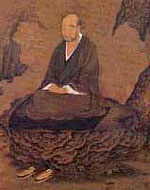Koso Wasan 27
The Emperor of Wei venerated him,
Giving him the title, 'Holy Luan';
The place where he lived came to be known
As Eminent Luan's Cliff.
The Silk Road

The place of T'an-luan's residence was Eminent Luan's Cliff. The pattern of building monasteries ('secluded places') in the sides of gorges, which were eroded by flash-floods and seasonal ice-melt water-courses through long æons, is a marked feature of desert (or 'oasis') Buddhism. As the dharma spread eastwards into more hospitable country a similar architectural pattern seems to have been maintained, thus recalling the centuries during which the home of the Buddha Dharma was in harsh climates: dry and experiencing extremes of heat and cold. Even today, east Asian temples sometimes remind us of those times, when they create wonderful gardens, which feature hardy shrubs and evergreen trees - perhaps representing desert tamarisks - and built along representations of dry water-courses that are made with gravel and rocks.
Oasis Buddhism describes a network of communities, which stretched from Bamiyan in present-day Afghanistan, across the western Himalayas and the Pamirs and along the network of routes that fringed the deserts of central Asia - on in to Xian in western China. This collection of roads was given the name 'The Silk Road'.
There are four monastic 'communities of the gorges' which seem to have been especially large and important centres. The oldest is Bamiyan, which is on the road from Kabul to Herat. Well-known features of Bamiyan are the statues of Buddha. They were carved into the rock-face of the river gorge and surrounded by cave monasteries. According to the seventh-century Chinese pilgrim Xuanzang some were gilded and others were coated in bronze. Two surviving statues were destroyed by the Taliban in 2001.
Mid-way along the span of the Silk Road was a huge monastic settlement - apparently consisting of 246 cave monasteries - on the northern edge of the Takla Makan (desert), near the oasis city of Kucha. It was in the gorge of a river created and sustained by the annual thaw in the mountains to the north. The location of these communities was known as Kizil. It features the 'Thousand Buddha Caves'. The paintings reveal a wide ethnic mix.
Further east along the northern road near the oasis city of Turfan is another ancient gorge community, this one also features a 'Thousand Buddha Cave' and, like Kizil, it is adorned with the familiar Hellenistic art of central-Asian Buddhism. Some of the monasteries were also built on the floor of the river channel.
Still in the desert but nearer to the more fertile eastern areas of China is Dunhuang. Dunhuang was only 'discovered' in the early twentieth century. I understand that it mimics the pattern found in all of the older gorge communities and it appears to have ended its days as a refuge for Buddhists fleeing the ruthless hordes led by Ghengis Khan. Ghengis Khan demonstrated religious tolerance - one of his wives was a Christian -, his own religion was one of the shamanistic faiths of Mongolia - but legend has it that, whenever he sacked a city or town, he killed every single inhabitant. It was perhaps Ghengis Khan who finally brought the already languishing Buddhist communities of central Asia to an end and Dunhuang has yeilded up a large repository of religious texts, which had been hidden away there, including the Buddhist canon and some Taoist and Nestorian works.
The Buddhism of mediæval central Asia was a power-house which fuelled the transmission of the dharma from its western cradle in Gandhara to China and then to Mongolia, Tibet, Korea and Japan. It is an extremely tolerant form of the dharma and adapted to harsh environmental conditions. Monasteries seem to have been increasingly self-sufficient and isolated; and some of them could have been huge and very wealthy. It is very likely that the Contemplation Sutra developed into its present form in central Asia - where there was a strong and growing emphasis on dhyana - and it was translated into Chinese by the central Asian native Kalayashas not long before T'an-luan's birth. The agent of T'an-luan's conversion to the Pure Land way was this same translation of the Contemplation Sutra, which was handed to him by Bodhiruchi.
The debt that the Pure Land stream of the Buddha Dharma owes to the people of ancient central Asia is significant.